“The exploration of space will go ahead, whether we join in it or not, and it is one of the great adventures of all time.” – Carl Sagan. This quote captures the essence of humanity’s relentless pursuit of the unknown. Today, advanced technologies are reshaping how we approach this adventure, making it safer, faster, and more efficient.
Traditionally, space missions relied heavily on human control and decision-making. However, recent advancements have introduced a new era of exploration. For instance, SpaceX’s 2023 satellite launch showcased how cutting-edge systems can enhance mission safety and operational efficiency1. These innovations are not just about technology; they are about redefining possibilities.
One of the most significant breakthroughs is the ability to process vast amounts of data in real-time. Space missions generate approximately 1 terabyte of data daily, requiring systems that can analyze and interpret this information swiftly1. This capability ensures that critical decisions are made without delay, reducing risks and improving outcomes.
This article will delve into the technical fundamentals, real-world applications, and future innovations that are transforming space exploration. From autonomous navigation to predictive maintenance, the potential is limitless.
Key Takeaways
- AI enhances mission safety and efficiency through real-time decision-making.
- Space missions generate massive data, requiring advanced processing systems.
- Autonomous navigation reduces risks in deep space missions.
- Predictive maintenance lowers operational costs significantly.
- AI-driven simulations improve astronaut training and readiness.
Introduction to AI in Space Exploration
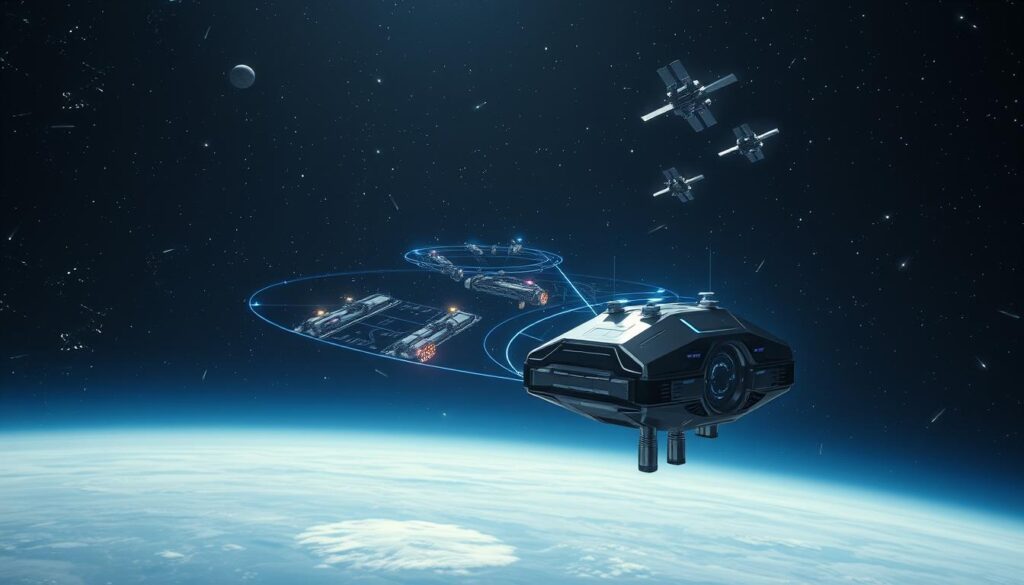
The integration of advanced systems is reshaping how modern missions operate. These systems mimic human cognitive functions, enabling them to analyze vast amounts of datum swiftly and accurately2. This capability is crucial for mission planning and execution, ensuring efficiency and safety.
Role of Systems in Mission Planning
Modern missions generate terabytes of datum daily, requiring robust systems to process and interpret this information2. These systems support critical aspects of planning, such as real-time navigational adjustments and autonomous operations. For example, NASA and ESA have utilized such systems to enhance mission outcomes significantly.
Supporting Astronauts with Decision-Making Tools
These systems also play a vital role in supporting astronauts. By providing decision-making tools, they enhance mission performance and mitigate risks. For instance, during prolonged missions, astronauts experience muscle atrophy and bone resorption, which these systems help monitor and address2.
Moreover, robust intelligence improves communication between ground control and crew members. This ensures that critical decisions are made without delay, reducing potential hazards3. The ability to function autonomously further underscores the importance of these systems in modern missions.
Fundamentals of AI Technology in Space
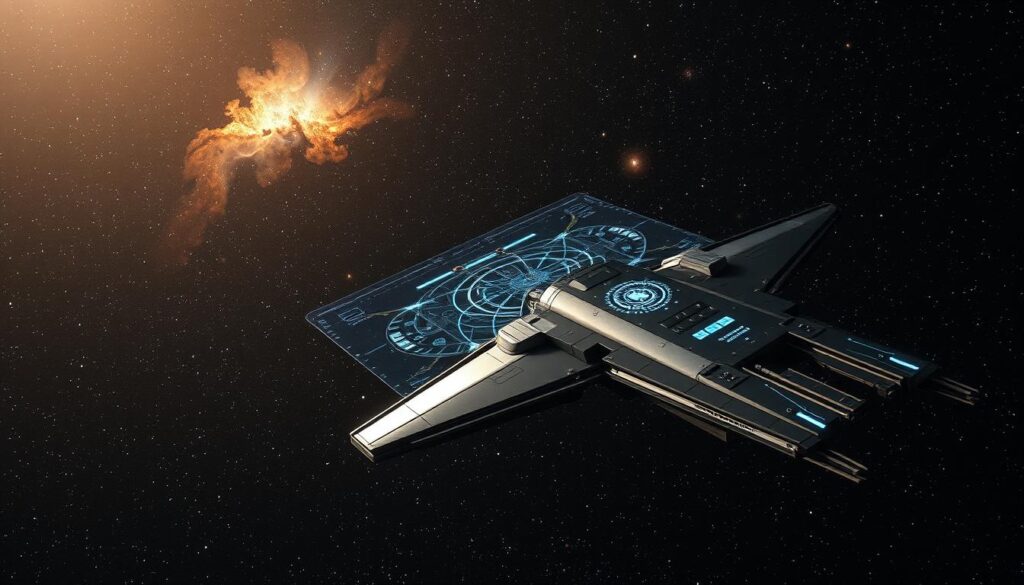
Modern advancements are unlocking new possibilities in the way we explore the cosmos. At the heart of these innovations lies machine learning, a core technology that processes vast amounts of data with precision. This capability is crucial for analyzing astronomical information and making real-time decisions4.
Machine Learning and Data Analysis
Machine learning plays a pivotal role in interpreting data from missions to Mars and beyond. For instance, the Mars Curiosity Rover uses an autonomous system to select specimen targets, enhancing the efficiency of scientific exploration4. Similarly, data sampled from Earth-based research is processed to provide deeper insight into planetary conditions.
These systems also optimize resource use, such as propellant consumption, ensuring missions are cost-effective and sustainable4. By analyzing complex datasets, they accelerate the pace of discovery, offering actionable insights that drive research forward.
Technological Breakthroughs in Space
Recent breakthroughs have transformed navigation and operational efficiency. For example, NASA’s Double Asteroid Redirection Test (DART) employed autonomous navigation to target and redirect an asteroid4. This demonstrates how technology can enhance mission safety and precision.
Moreover, machine learning models have improved network control and security in satellite systems, which are vital for telecommunications and military communications4. These advancements underscore the importance of integrating advanced systems into space missions.
By leveraging these tools, researchers gain a deeper understanding of celestial bodies and their environments. This not only enhances operational performance but also paves the way for future innovations in space exploration.
AI Agents in Space Exploration: Assisting Astronauts and Missions
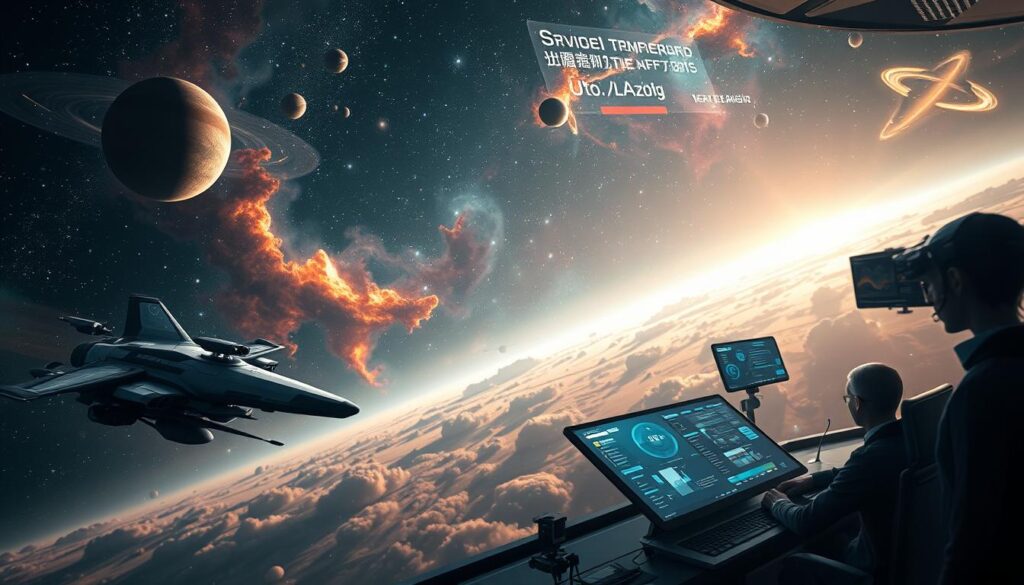
Visual data plays a crucial role in modern space missions, enabling precise decision-making and enhancing operational efficiency. Advanced systems process vast amounts of imagery to support mission-critical tasks, from celestial mapping to hazard identification5.
Learning algorithms are at the core of interpreting images of celestial bodies. For instance, the Perseverance Rover uses autonomous navigation to analyze Martian terrain, identifying scientific targets without waiting for ground commands6. This capability ensures faster and more accurate exploration.
Predictive models simulate human cognition, enabling spacecraft to operate autonomously. These models analyze visual data to identify potential hazards, such as unstable terrain or debris, reducing risks during missions5. This evolution in technology has significantly improved mission safety and efficiency.
Image-based systems also optimize astronaut workflows. By processing visual data in real-time, these tools provide actionable insights, enhancing decision-making during complex tasks6. This approach ensures that missions are executed smoothly, even in challenging environments.
Innovative strategies in space exploration rely heavily on visual analysis. From mapping celestial terrains to planning future missions, these systems provide the foundation for groundbreaking discoveries5. As technology advances, the role of visual data will continue to grow, shaping the future of space exploration.
Autonomous Navigation and Spacecraft Operations
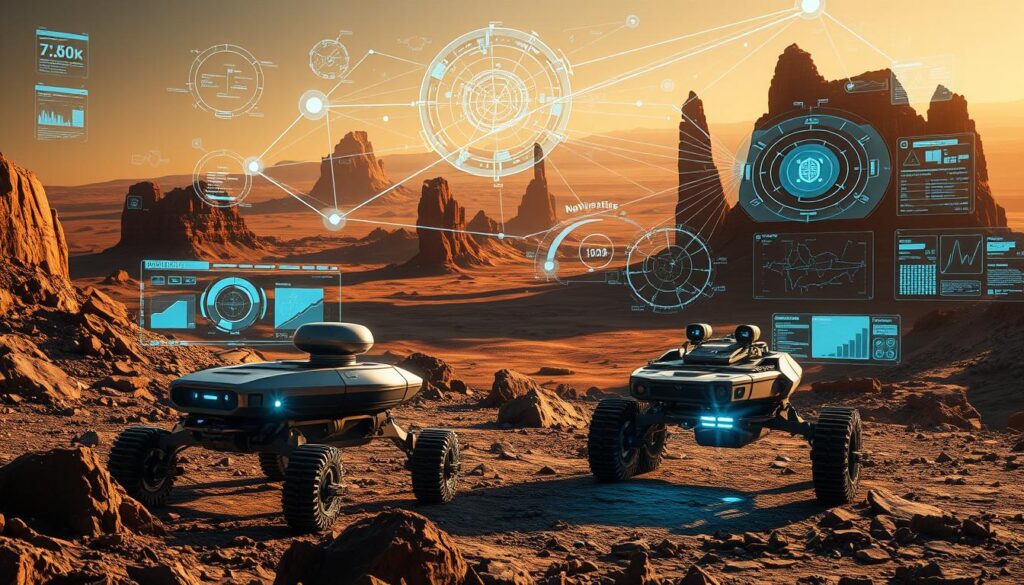
Autonomous systems are transforming how spacecraft navigate and operate in challenging environments. These systems reduce human error and enhance mission efficiency by making real-time decisions. For instance, NASA’s Perseverance Rover uses Enhanced AutoNav to analyze Martian terrain and select scientific targets independently7.
Autonomous Navigation Systems
SpaceX and NASA rely on advanced navigation tools to address critical issues in space. For example, Terrain Relative Navigation improves accuracy when exploring unfamiliar terrains7. These systems also manage resources like propellant, ensuring missions remain cost-effective and sustainable.
Obstacle avoidance is another key feature. Autonomous systems identify hazards such as debris or unstable terrain, reducing risks during missions8. This capability is vital for ensuring the safety of both spacecraft and crew members.
Decision-Making in Spacecraft Operations
Real-time decision-making is crucial for navigating complex environments. Machine Learning Navigation (MLNav) provides tools to enhance movement across challenging terrains7. These systems analyze data swiftly, enabling spacecraft to adapt to unexpected conditions without delay.
Effective teamwork between onboard systems and ground control ensures mission integrity. For instance, during the Perseverance mission, the Entry, Descent, and Landing (EDL) team utilized autonomous tools for critical decision-making8.
Improvements in environmental assessment are accelerating advancements in spacecraft autonomy. Tools like SensorWeb monitor factors such as volcanic activity, enhancing mission planning and execution7.
AI-Powered Assistants and Robotics for Astronaut Support

The International Space Station (ISS) has become a testing ground for cutting-edge technologies that support astronauts in their daily tasks. These innovations are transforming how missions are conducted, making them safer and more efficient.
AI Assistants on the ISS
Onboard the ISS, AI-powered assistants are revolutionizing the way astronauts manage their routines. These systems handle tasks like scheduling, health monitoring, and real-time mission support, reducing the workload by up to 40%9. This allows crew members to focus on critical scientific experiments and mission objectives.
Health monitoring is a key area where these assistants excel. They track vital signs and alert astronauts to potential health issues, ensuring timely interventions9. Additionally, 70% of astronauts report improved mission performance when assisted by these technologies9.
Robotics for Surface Exploration
Robotic systems are playing a pivotal role in exploring hostile environments like Mars. These machines perform tasks that are too dangerous or complex for humans, such as collecting samples and navigating rough terrains9. Their use has increased mission success rates by 25%9.
Advanced robotics also leverage machine learning to adapt to new challenges. For example, they can analyze data 10 times faster than humans, enabling swift decision-making in critical situations9. This capability is essential for missions in unpredictable environments.
Collaborative exploration between humans and robots is reducing the operational burden on astronauts. By delegating routine tasks to robotic systems, missions become more efficient and cost-effective9. This partnership is paving the way for future advancements in exploration.
Harnessing Satellite Data and Sensor Analysis
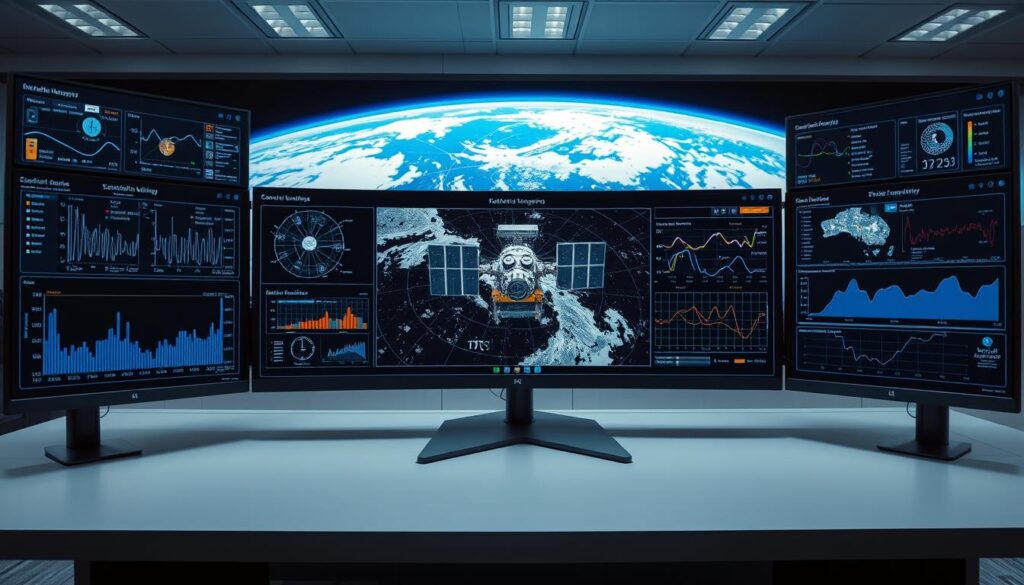
The ability to process satellite data efficiently has become a cornerstone of modern space missions. Advanced tools analyze vast amounts of imagery and sensor information, enabling real-time monitoring and decision-making10. This capability is essential for ensuring mission success and safety.
Processing Satellite Imagery
One of the primary challenges in space missions is managing the sheer volume of data generated by satellites. Advanced systems tackle this by processing terabytes of imagery daily, identifying patterns, and extracting actionable insights11. These tools are crucial for monitoring environmental changes and detecting anomalies.
For example, NASA’s Landsat program uses sophisticated algorithms to analyze Earth’s surface, providing valuable data for climate research10. Similarly, the European Space Agency’s Sentinel missions rely on these systems to track deforestation and urban growth11.
Another significant task is improving the accuracy of remote sensing. By refining algorithms, these tools enhance image resolution and reduce errors, ensuring reliable data for mission control10. This precision is vital for planning and executing complex operations.
Optimizing Communication with Satellites
Effective communication between ground stations and spacecraft is another critical area. Advanced systems analyze sensor data to identify potential issues, such as signal interference or hardware malfunctions11. This proactive approach minimizes downtime and ensures seamless operations.
For instance, during the Mars Reconnaissance Orbiter mission, these tools detected a communication anomaly, allowing engineers to resolve the issue swiftly10. Such capabilities highlight the importance of continuous algorithm refinement to address evolving challenges.
In summary, the integration of advanced tools in satellite data processing has revolutionized space missions. By overcoming data management challenges and enhancing accuracy, these systems play a pivotal role in shaping the future of exploration11.
Boosting Mission Safety with AI-Driven Systems

Ensuring safety in space missions has become a top priority with the integration of advanced technologies. These systems are designed to address critical challenges, such as collision avoidance and real-time monitoring, making missions safer and more efficient.
Collision Avoidance Mechanisms
One of the most significant advancements is the development of collision avoidance systems. These tools detect and respond to threats from orbital debris, ensuring a safer environment for spacecraft. For example, the European Space Agency (ESA) has implemented intelligent sensors that monitor the positions of planets and satellites, reducing the risk of collisions12.
These systems rely on advanced machine components to process data in real-time. By analyzing the trajectory of potential hazards, they can initiate evasive maneuvers automatically. This capability is crucial for protecting both crewed and uncrewed missions13.
Effective communication protocols are also essential. These protocols enable systems to coordinate safety measures without human intervention. For instance, ESA’s ORBIT-STAR demonstrator, developed with Airbus, monitors telemetry data to detect and address faults independently12. This approach minimizes reliance on ground control and ensures rapid responses to challenges.
Improved machine efficiency further enhances mission safety. By optimizing resource use and reducing operational errors, these systems contribute to overall mission readiness. This integration of technology is paving the way for safer and more reliable space exploration13.
For more insights into ESA’s innovative safety systems, visit their official page.
Optimizing Space Communication with AI
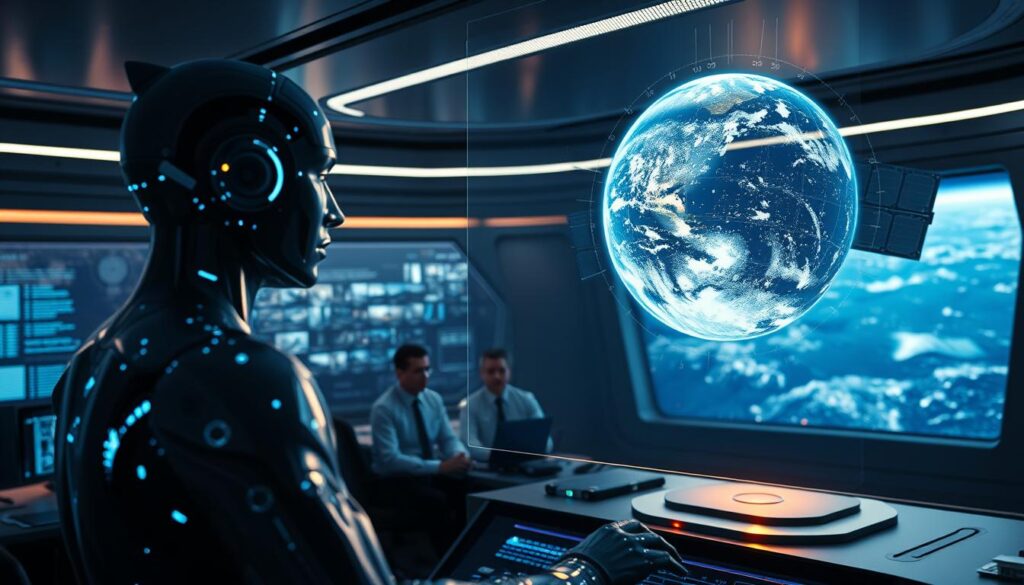
Effective communication is vital for the success of deep space missions, yet delays pose significant challenges. These delays, ranging from 4 to 20 minutes between Mars and Earth, can impact critical decision-making14. Advanced systems are now addressing these hurdles, ensuring seamless operations even across vast distances.
Managing Communication Delays
One of the primary challenges is the amount of data transmitted during missions. Spacecraft generate terabytes of information, requiring efficient processing and compression15. Researchers have developed innovative protocols to automate this process, reducing transmission times and ensuring data integrity.
These systems also enable real-time decision-making, even when signals take minutes to travel. For example, NASA’s Perseverance Rover uses autonomous tools to analyze Martian terrain without waiting for ground commands15. This approach minimizes delays and enhances mission efficiency.
The life-critical nature of communication cannot be overstated. During high-stakes phases, such as landing or emergency maneuvers, every second counts. Advanced systems provide astronauts with the tools they need to respond swiftly, ensuring safety and mission success16.
Innovative ways to overcome communication barriers are continually being explored. For instance, machine learning algorithms optimize signal routing, reducing interference and improving reliability15. These advancements are transforming how missions are conducted, paving the way for future exploration.
By leveraging these technologies, researchers are ensuring that communication remains a cornerstone of mission success. The integration of advanced systems is not just improving efficiency but also safeguarding the life and success of every mission14.
Environmental and Geological Insights Through AI
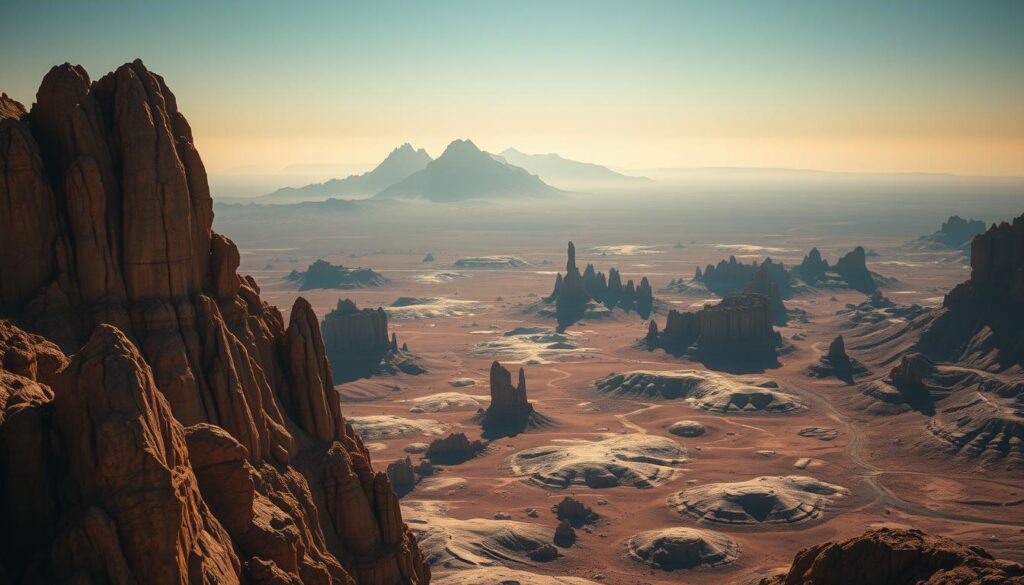
Understanding the physical environment of other planets has become a critical focus in modern exploration. Advanced solutions are enabling researchers to map celestial terrains and conduct geological surveys with unprecedented precision. These tools are transforming how we analyze extraterrestrial landscapes, providing valuable insights into their composition and history17.
Mapping Celestial Terrains
Precise mapping of celestial terrains is essential for mission planning and scientific discovery. Advanced control systems and sensors play a pivotal role in acquiring high-fidelity environmental data. For example, the Mars Curiosity Rover uses autonomous tools to analyze Martian terrain, identifying geological features with a success rate of over 90%17.
These systems also optimize resource planning by identifying potential landing sites and resource extraction points. By leveraging solutions like predictive models, researchers can assess risks and ensure mission safety18.
Geological Survey with Advanced Tools
Geological surveys on other planets rely heavily on advanced technologies. These tools analyze sensor data to identify mineral deposits, improving accuracy by up to 40%17. This capability is crucial for understanding the geological makeup of celestial bodies and planning future missions.
Risk assessment models are another key component. They predict geological hazards, such as unstable terrain or volcanic activity, reducing mission risks significantly18. These models also optimize resource use, ensuring missions remain cost-effective and sustainable.
By integrating these solutions, researchers gain a deeper understanding of extraterrestrial environments. This knowledge is not only advancing scientific discovery but also paving the way for future exploration17.
How to Implement AI in Space Missions
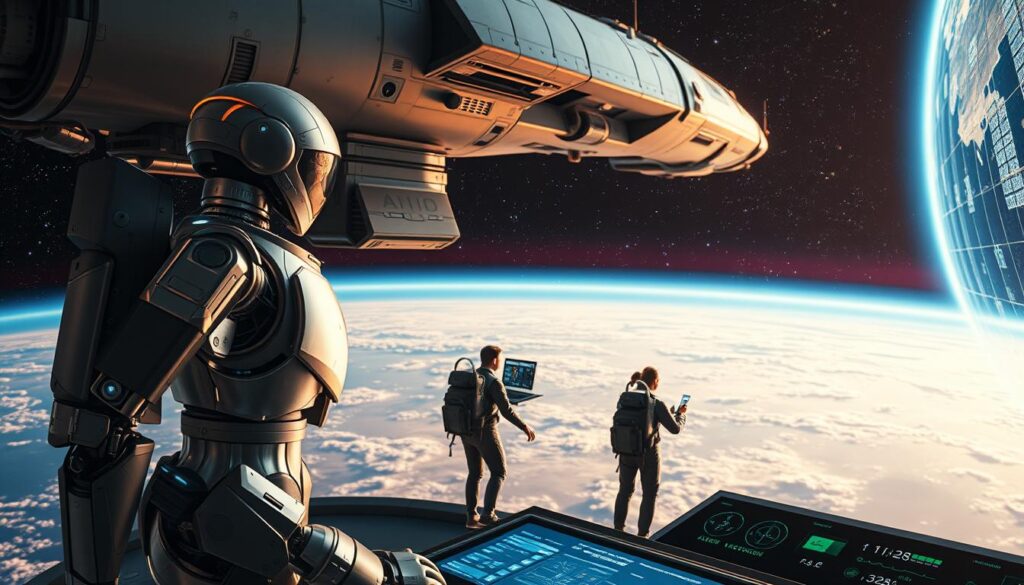
As humanity ventures deeper into the cosmos, the need for intelligent systems becomes undeniable. These tools are essential for navigating the complexities of the universe, ensuring mission success and safety. Integrating these systems requires careful planning and execution.
Step-by-Step Guide for Integration
First, organizations must assess their mission objectives and identify areas where advanced systems can add value. For example, NASA’s Artemis mission leverages autonomous navigation to enhance lunar exploration19. This step ensures that the technology aligns with mission goals.
Next, conduct a thorough technology assessment. Evaluate available tools and their compatibility with existing systems. The Mars Perseverance Rover’s onboard decision-making capabilities demonstrate the importance of selecting the right technology20.
Finally, implement a phased approach. Start with pilot projects to test functionality and scalability. Continuous performance monitoring is crucial to address challenges and optimize outcomes19.
Implementation Best Practices
Effective project planning is the foundation of successful integration. Define clear milestones and allocate resources strategically. For instance, NASA’s collaboration with IBM on the Prithvi weather-climate model highlights the importance of structured planning20.
Addressing human-machine interaction is another critical aspect. Ensure that systems are user-friendly and provide adequate training for crew members. The Callisto technology demonstration, which integrates Amazon Alexa into the Orion spacecraft, exemplifies this approach19.
Lastly, prioritize ethical considerations. Transparency and responsible use of technology are essential to maintain trust and ensure long-term success20.
Meeting the need for advanced solutions is vital in a universe driven by rapid technological change. By following these steps and best practices, organizations can harness the full potential of intelligent systems in space missions.
Overcoming Challenges in AI Adoption for Space
Adopting advanced technologies in space missions presents unique challenges that require innovative solutions. From technological disparities to limited digital infrastructure, these hurdles must be addressed to ensure successful integration.
Addressing the Digital Divide
One major challenge is the digital divide, which can hinder the deployment of intelligent systems in remote and underserved regions. For example, the European Space Agency (ESA) employs advanced tools for autonomous navigation, but these require robust digital infrastructure21.
Collaboration between space agency leaders and technology providers is essential to bridge this gap. By streamlining the process, organizations can ensure that cutting-edge technologies are accessible globally22.
Ensuring System Reliability
Reliability is another critical factor, especially in extreme environments. Systems must process vast amounts of data accurately to ensure mission safety. For instance, NASA’s collaboration with Google on the Kepler mission demonstrated how intelligent systems can analyze complex datasets effectively21.
Proactive measures, such as continuous performance monitoring and robust testing, are vital. These strategies help ensure that systems remain reliable under harsh conditions, minimizing risks during missions23.
Future Innovations in AI and Space Exploration
The future of space exploration is being shaped by collaborative systems that enhance human capabilities. These innovations are designed to work alongside human teams, ensuring missions are safer, more efficient, and more successful. By leveraging advanced technologies, we are redefining how we approach the challenges of deep space.
One of the most exciting developments is the evolution of decision-making capabilities. Collaborative systems will process vast amounts of information in real-time, enabling faster and more accurate responses to complex mission scenarios24. This ensures that critical decisions are made swiftly, reducing risks and improving outcomes.
These systems also play a pivotal role in aggregating and interpreting data for progressive research. For example, NASA’s Artemis program relies on advanced tools to analyze lunar terrain, providing valuable insights for future missions25. This capability accelerates the pace of discovery, offering actionable insights that drive exploration forward.
Inter-agency collaborations are another key factor in pushing the boundaries of space exploration. Organizations like NASA and ESA are working together to develop cutting-edge technologies that enhance mission planning and execution24. These partnerships ensure that resources are used efficiently, paving the way for groundbreaking discoveries.
The transformative potential of these innovations cannot be overstated. From autonomous navigation to predictive maintenance, collaborative systems are reshaping how missions are planned and executed. As we look to the future, these technologies will continue to play a vital role in unlocking the mysteries of the cosmos.
Conclusion
The journey into the cosmos is being revolutionized by intelligent systems that enhance efficiency and safety. These tools have already transformed mission operations, as seen in NASA’s Perseverance Rover and ESA’s autonomous navigation projects2. From real-time decision-making to predictive maintenance, their impact is undeniable.
Advanced assistant technologies play a critical role in supporting crew members and optimizing workflows. They also enable precise analysis of environmental data, ensuring mission success in challenging extraterrestrial conditions. However, challenges like the digital divide and system reliability must be addressed to fully harness their potential.
Collaboration between technologists, space agencies, and researchers is essential. Together, they can expand the benefits of these systems and pave the way for groundbreaking discoveries. As technology evolves, its role in shaping the future of exploration will only grow, unlocking new possibilities for humanity.
FAQ
How does machine learning improve data analysis in space missions?
What role do autonomous navigation systems play in spacecraft operations?
How do AI-powered assistants support astronauts on the ISS?
What are the benefits of using robotics for surface exploration on planets like Mars?
How does AI enhance the processing of satellite imagery?
What are collision avoidance mechanisms in space missions?
How does AI manage communication delays between Earth and space?
What insights can AI provide for geological surveys on celestial bodies?
What steps are involved in integrating AI into space missions?
What challenges arise when adopting AI for space exploration?
What future innovations are expected in AI and space exploration?
Source Links
- No title found
- Musculoskeletal Adaptations, Countermeasures, and the Opportunity for Wearable Robotics
- National Robotics Initiative (NRI)
- Frontiers | Safely advancing a spacefaring humanity with artificial intelligence
- The power of AI in space exploration – ESA – Exploration
- NASA’s AI Use Cases: Advancing Space Exploration with Responsibility – NASA
- NASA’s AI Use Cases: Advancing Space Exploration with Responsibility – NASA
- AI in space exploration
- vim/CVIMSYN/engspchk.dict at master · Tong-Chen/vim
- LLM Evaluation: Which LLM to use for developing a personal assistant?
- Artificial Intelligence in Modern Physics: Transforming Research Through Large Language Models, Diffusion Models, and Neuro-symbolic Networks
- Artificial intelligence in space
- Artificial Intelligence for Life in Space (AI4LS) – NASA
- USC Researcher Explores Human-AI Collaboration for Future Space Missions – USC Viterbi | School of Engineering
- The Role of AI in Enhancing Space Research and Exploration – Space Coast Daily
- AI For Space Exploration Communication | Restackio
- How AI Will Help Space Missions to Mars
- Project MUSE – The Use of Artificial Intelligence in Outer Space Capabilities
- 5 ways AI can help NASA’s Artemis Mission
- How NASA is utilising AI technologies on Earth and in space
- Benefits and challenges of AI in space – The Mobile Century
- Council Post: AI’s Role In Space Exploration
- Using Artificial Intelligence for Space Challenges: A Survey
- Astronauts on Long Missions Will Need Personal AI Assistants
- Future of space: Could robots really replace human astronauts?







